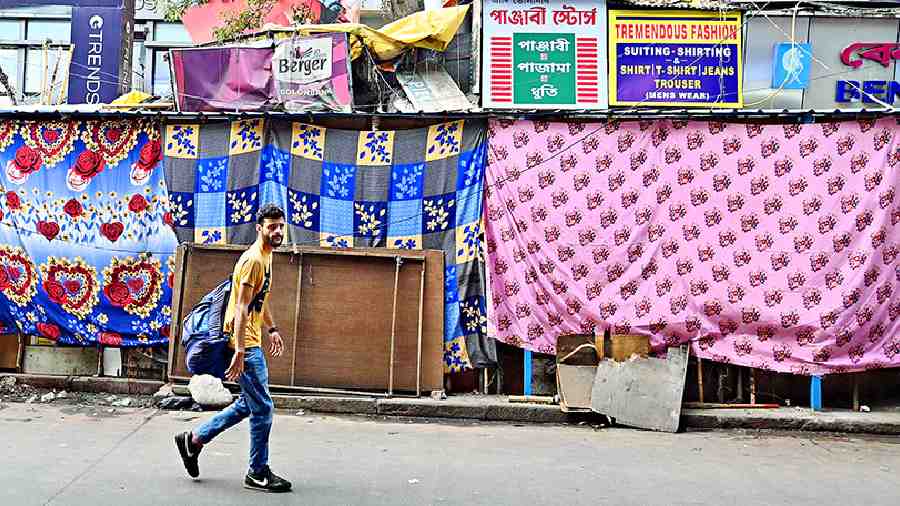Torn and stained pieces of cloth hang around hawkers’ stalls in Gariahat days after plastic sheets were removed, making the pavements look as ugly as before, if not more.
The reason for barring plastic sheets — they are flammable — holds true for cloths, too, said architect Abin Chaudhuri, who has designed many public spaces in the city.
Until a week ago, most stalls were covered by plastic sheets to protect the merchandise from dust and dirt. The plastic sheets, which covered the top and three sides, were removed after repeated prods by the Kolkata Municipal Corporation (KMC).
Hawking rules framed by the state government ban the use of plastic sheets in the stalls.
Hawkers built a tin shade above their stalls on a small stretch of the footpath near the Gariahat crossing last Monday. The sides, however, were kept open.
Earlier this month, the KMC had allowed hawkers to replace plastic sheets over their stalls with a tin shade.
The Telegraph visited Gariahat on Sunday and found that most of the stalls that removed plastic sheets have hung cloths, including bedsheets, around stalls. Some hawkers have hung cloths above the stalls, too. Even some of the stalls that have a tin shade have cloths hanging at the rear.
Debraj Ghosh, a leader of the hawker’s union in Gariahat, said on Sunday cloths were hung at the rear of the stalls as dust from the road was damaging the wares. “There is so much dust that some protection is required. We are planning to use some well-designed cover at the rear,” Ghosh said.
After the plastic sheets were removed, one could see the shops lining the road through the stalls. But with hawkers tying up cloths, the view has again been blocked.
“The stalls could have been designed in an aesthetic way that would have made the entire place look better. The issue of how they get electricity should be addressed immediately. Loose wires tied here and there should be... hidden,” architect Chaudhuri said.
Debasish Kumar, mayoral council member heading the parks and squares department of the KMC, said cloths had been put up around stalls that lack a tin shade. “Once the tin shade has been erected, no one will be allowed to use cloth pieces. The sides have to be kept open,” he said.
Hawking rules say stalls cannot encroach on a road or face the road, and no hawker can occupy more than a third of the width of the pavement.
All across Kolkata, including Gariahat, stalls have encroached on roads.
Chaudhuri said “cloth pieces, too, are flammable and are dangerous to use”.
A fire that started on the footpath outside Gurudas Mansion, at the north-western corner of the Gariahat crossing, allegedly spread to the building because of the plastic sheets tied over the stalls.
Fires can spread through cloths, too, warned a resident.
Kumar said the KMC had plans to install a material at the rear of the stalls where advertisements can be displayed. “That will generate some revenue for the KMC,” he said.


